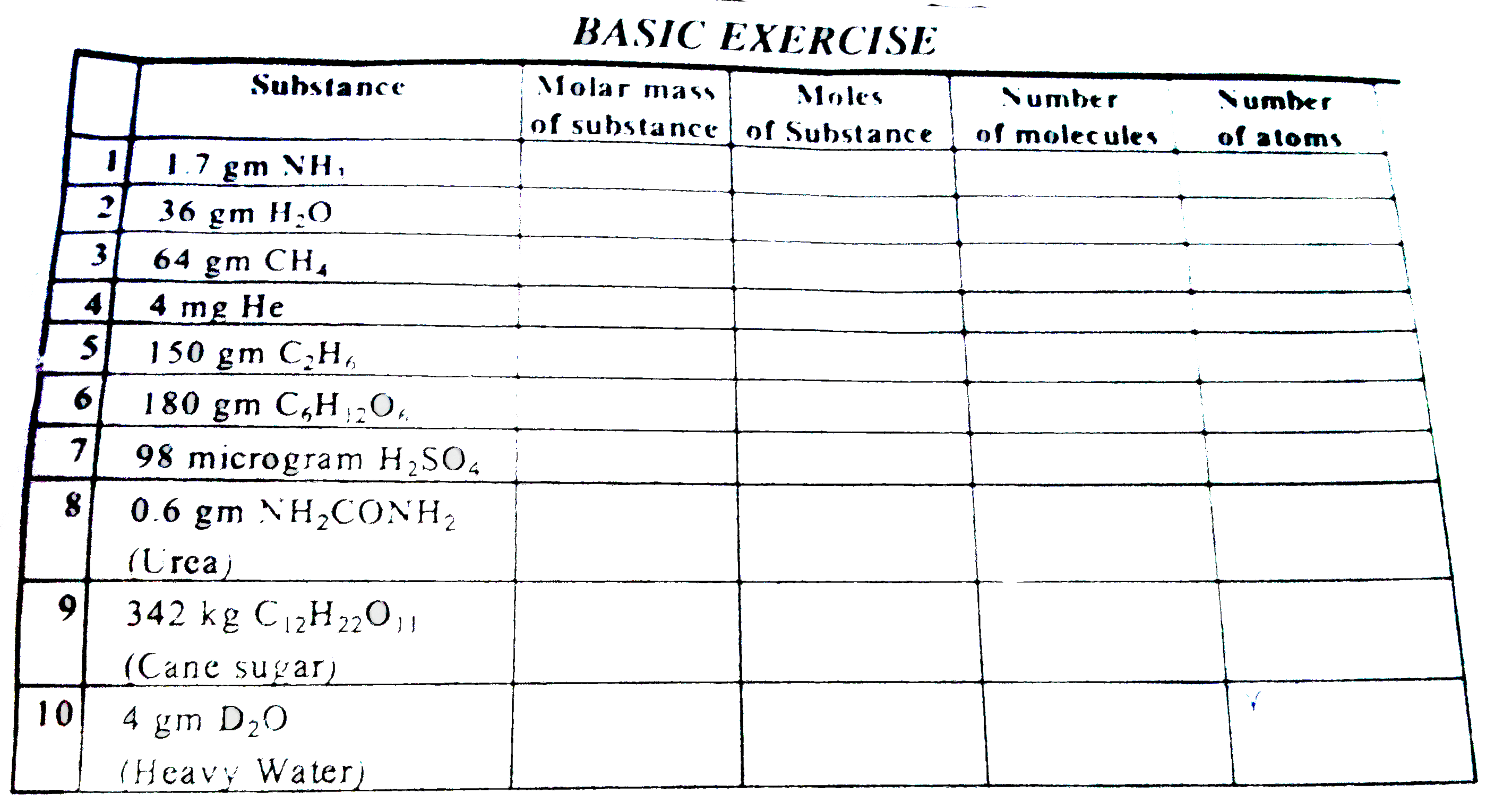The number of atoms in 0.1 mole of a triatomic gas is (NA=6.02×1023mol−1)
6.026×1022
1.806×1023
3.600×1023
1.800×1022
The correct Answer is:B
To find the number of atoms in 0.1 mole of a triatomic gas, we can follow these steps:
Step 1: Understand the concept of moles and atoms
- A triatomic gas consists of molecules that each contain three atoms.
Step 2: Calculate the number of moles of atoms in 0.1 mole of triatomic gas
- Since each molecule of the triatomic gas has 3 atoms, 1 mole of triatomic gas will have 3 moles of atoms.
- Therefore, in 0.1 mole of triatomic gas, the number of moles of atoms can be calculated as:
Moles of atoms=0.1mole of triatomic gas×3atoms/molecule=0.3moles of atoms
Step 3: Use Avogadro's number to find the number of atoms
- Avogadro's number (NA) is 6.022×1023atoms/mole.
- To find the total number of atoms, we multiply the number of moles of atoms by Avogadro's number:
Number of atoms=Moles of atoms×NA=0.3moles of atoms×6.022×1023atoms/mole
Step 4: Perform the calculation
- Now, calculate the number of atoms:
Number of atoms=0.3×6.022×1023=1.806×1023atoms
Conclusion
- Therefore, the number of atoms in 0.1 mole of a triatomic gas is 1.806×1023atoms.
---
- A triatomic gas consists of molecules that each contain three atoms.
- Since each molecule of the triatomic gas has 3 atoms, 1 mole of triatomic gas will have 3 moles of atoms.
- Therefore, in 0.1 mole of triatomic gas, the number of moles of atoms can be calculated as:
Moles of atoms=0.1mole of triatomic gas×3atoms/molecule=0.3moles of atoms
- Avogadro's number (NA) is 6.022×1023atoms/mole.
- To find the total number of atoms, we multiply the number of moles of atoms by Avogadro's number:
Number of atoms=Moles of atoms×NA=0.3moles of atoms×6.022×1023atoms/mole
- Now, calculate the number of atoms:
Number of atoms=0.3×6.022×1023=1.806×1023atoms
- Therefore, the number of atoms in 0.1 mole of a triatomic gas is 1.806×1023atoms.
Topper's Solved these Questions
- SOME BASIC CONCEPTS OF CHEMISTRY BOOK - ICSECHAPTER - SOME BASIC CONCEPTS OF CHEMISTRY EXERCISE - TRUE OR FALSE TYPE QUESTIONS
10 Videos
- SOME BASIC CONCEPTS OF CHEMISTRY BOOK - ICSECHAPTER - SOME BASIC CONCEPTS OF CHEMISTRY EXERCISE - FILL IN THE BLANKS TYPE QUESTIONS
10 Videos
- SOME BASIC CONCEPTS OF CHEMISTRY BOOK - ICSECHAPTER - SOME BASIC CONCEPTS OF CHEMISTRY EXERCISE - ESSAY LONG ANSWER TYPE QUESTIONS
15 Videos
- SELF ASSESSMENT PAPER 2BOOK - ICSECHAPTER - SELF ASSESSMENT PAPER 2EXERCISE - Questions
62 Videos
- SOME P-BLOCK ELEMENTS BOOK - ICSECHAPTER - SOME P-BLOCK ELEMENTS EXERCISE - NCERT TEXTBOOK EXERCISES (With Hints and Solutions)
63 Videos
Similar Questions
The number of atoms in 0.1 mol of a tetraatomic gas is (NA=6.02×1023mol−1)
View SolutionThe critical micelle concentration (CMC) of a cationic colloidal electrolyte is 10−3 M. If 1 mm3 contains 1013 micelles, the number of cations making one micells is
(Given, NA=6.0×1023mol−1)
View SolutionCalculate number of atoms in 0.2 mole of oxygen atoms.
View SolutionThe total number of protons in 10 g of calcium carbonate is (N0=6.023×1023) :-
View SolutionSilver crystallises in a fcc lattice. The edge length of its unit is 4.077×10−8cm and its density is 10.5gcm−3. Claculate on this basis of the atomic mass of silver (NA=6.02×1023mol−1)
View SolutionAn element 'X' (At. Mass = 40 g mol−1) having f.c.c structure has unit cell edge length of 400 pm . Calculate the density of 'X' and the number of unit cells in 4 g of 'X' .
(NA=6.022×1023mol−1).
View Solution
A box contains 12×1022 number of oxygen atoms. Find moles of O-atoms? (NA=6×1023)
View SolutionSilver crystalilises in a fcc lattice. The edge length of its unit is 4.077×10−8×cm and its density is 10.5gcm−3. Claculate on this basis the atomic mass of silver (NA=6.02×1023mol−1)
View SolutionLithium has a bcc structure .Its density is 530kgm−3 and its atomic mass is 6.94gmol−1 .Calculate the edge length of a unit cell of lithium metal (NA=6.02×1023mol−1)
View SolutionLithium has a bcc structure .Its density is 530kgm−3 and its atomic mass is 6.94gmol−1 .Calculate the edge length of a unit cell of lithium metal (NA=6.02×1023mol−1)
View Solution
